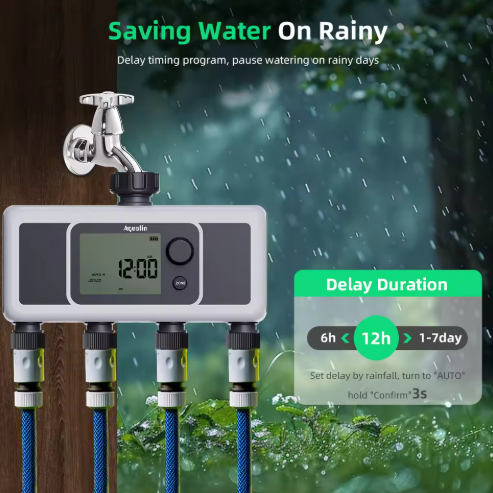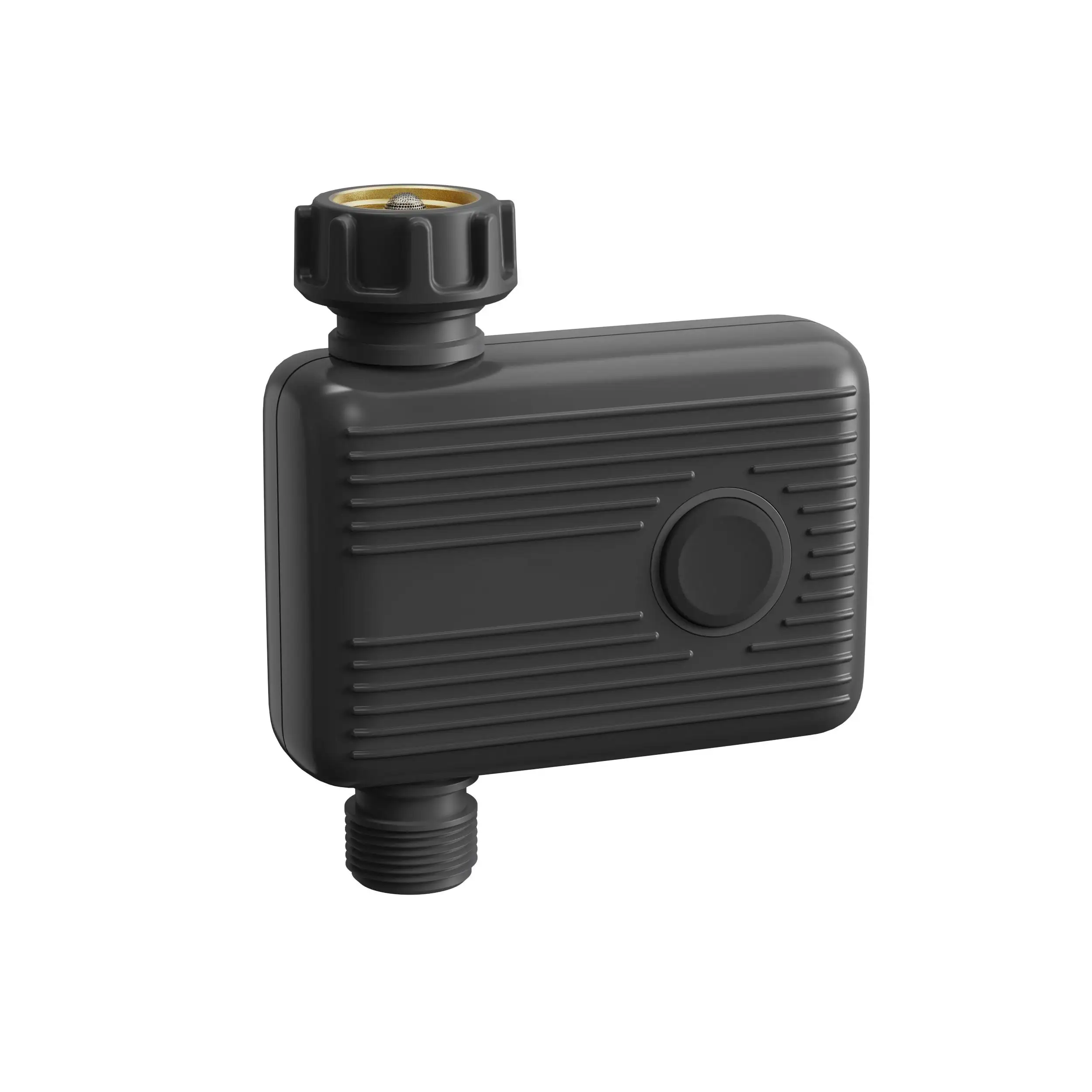Transformez l'entretien de votre jardin grâce à la technologie d'irrigation automatisée
L'entretien du jardin exige de la rigueur, du temps et de la constance, surtout en matière d'arrosage. Un réglage Automatique de l'Eau représente une avancée révolutionnaire dans les soins aux jardins, offrant une précision, un confort et une efficacité dans l'utilisation des ressources que l'arrosage manuel ne peut tout simplement pas égaler. Alors que les jardins deviennent de plus en plus sophistiqués et que la conscience environnementale s'accroît, la mise en œuvre d'un système de réglage Automatique de l'Eau a émergé comme solution essentielle tant pour les jardiniers débutants que pour les horticulteurs expérimentés.
Les minuteries d'arrosage modernes combinent une technologie innovante avec une fonctionnalité pratique, offrant un arrosage programmé qui maintient votre jardin en pleine santé tout en économisant l'eau et en réduisant les efforts d'entretien. Cet outil sophistiqué mais convivial a transformé notre manière de prendre soin du jardin, rendant possible le maintien de plantes luxuriantes et saines même avec un mode de vie occupé.
Les avantages essentiels des systèmes de minuterie d'arrosage
Précision et régularité des horaires d'arrosage
L'un des avantages les plus significatifs de l'utilisation d'une minuterie d'arrosage est la possibilité de maintenir des horaires d'arrosage précis et réguliers. Les plantes prospèrent grâce à la routine, et une minuterie d'arrosage garantit qu'elles reçoivent exactement la quantité d'eau nécessaire aux moments précis. Cette régularité favorise un développement racinaire plus fort, une meilleure absorption des nutriments et une croissance végétale globalement améliorée.
Contrairement à l'arrosage manuel, qui peut être irrégulier et subjectif, un programmateur d'arrosage délivre des quantités mesurées d'eau à des intervalles prédéfinis. Cette précision évite à la fois le surarrosage et le sous-arrosage, des problèmes fréquents pouvant entraîner un stress chez les plantes, des maladies et une croissance médiocre.
Économie de temps et d'énergie
L'installation d'un programmateur d'arrosage réduit considérablement le temps et l'effort physique nécessaires à l'entretien du jardin. Plutôt que de passer des heures à arroser manuellement votre jardin, vous pouvez programmer le minuteur une seule fois et lui confier automatiquement les tâches routinières. Cette automatisation libère du temps précieux pour d'autres activités de jardinage ou pour vos loisirs personnels.
Les économies d'énergie vont au-delà de l'effort personnel : de nombreux programmateurs d'arrosage modernes sont conçus pour fonctionner avec une consommation d'énergie minimale, ce qui en fait un choix respectueux de l'environnement dans une démarche de jardinage durable.

Fonctionnalités avancées des programmateurs d'arrosage modernes
Intégration de la technologie intelligente
Les programmateurs d'arrosage modernes se sont dotés de technologies intelligentes, offrant des fonctionnalités impensables encore il y a quelques années. De nombreux modèles intègrent désormais une connectivité Wi-Fi, permettant aux utilisateurs de contrôler leurs systèmes d'irrigation via des applications pour smartphones. Cette possibilité d'accès à distance permet des ajustements en temps réel des horaires d'arrosage, des mises à jour instantanées du système et le suivi des habitudes de consommation d'eau.
Certains programmateurs d'arrosage avancés intègrent même des fonctions de surveillance météorologique, ajustant automatiquement les plannings d'arrosage en fonction des conditions climatiques locales. Cet ajustement intelligent évite un arrosage inutile pendant les périodes de pluie et augmente l'apport en eau durant les sécheresses.
Options de programmation personnalisables
Les programmateurs d'arrosage modernes offrent une grande flexibilité de programmation afin de répondre aux besoins variés du jardinage. Les utilisateurs peuvent définir plusieurs zones d'arrosage, établir des plannings différents selon les types de plantes et effectuer des ajustements saisonniers. Cette personnalisation garantit que chaque zone de votre jardin reçoive des soins optimaux adaptés à ses besoins spécifiques.
La possibilité de créer des plannings d'arrosage complexes permet un contrôle précis de la distribution d'eau tout au long de la journée. Par exemple, vous pouvez programmer un arrosage tôt le matin pour minimiser l'évaporation, ou définir des durées spécifiques pour différentes zones de plantes en fonction de leurs besoins en eau.
Économie d'eau et impact environnemental
Réduction du gaspillage d'eau
La conservation de l'eau est devenue de plus en plus importante dans le jardinage moderne, et les programmateurs d'arrosage jouent un rôle essentiel pour limiter le gaspillage. En délivrant des quantités précises d'eau aux moments optimaux, ces systèmes évitent l'arrosage excessif et réduisent le ruissellement. Des études ont montré que les systèmes d'irrigation automatisés avec une bonne programmation peuvent réduire la consommation d'eau jusqu'à 30 % par rapport aux méthodes d'arrosage manuel.
La précision des programmateurs d'arrosage aide également à maintenir un taux d'humidité adéquat du sol, en évitant la perte d'eau par évaporation et en garantissant que les plantes reçoivent de l'eau au moment où elles peuvent l'utiliser le plus efficacement.
Pratiques de jardinage durables
La mise en œuvre d'un programmateur d'arrosage s'inscrit dans les principes de jardinage durable. Ces dispositifs favorisent des pratiques écologiques en optimisant l'utilisation de l'eau et en réduisant l'impact environnemental global de l'entretien des jardins. La distribution contrôlée de l'eau contribue également à prévenir l'érosion des sols et le lessivage des nutriments, ce qui améliore l'écologie du sol.
De nombreux programmateurs d'eau modernes incluent des fonctionnalités qui soutiennent des pratiques durables, telles que la détection de pluie capteurs empêchant l'arrosage pendant les précipitations naturelles, ainsi que des débitmètres détectant les fuites ou une consommation excessive d'eau.
Considérations d'installation et d'entretien
Installation et intégration
L'installation d'un programmateur d'eau implique généralement des étapes simples que la plupart des jardiniers peuvent réaliser sans assistance professionnelle. La configuration de base consiste à raccorder le programmateur à une source d'eau, comme un robinet extérieur, puis à le connecter à votre système d'irrigation ou à vos tuyaux existants. Les modèles modernes disposent d'interfaces conviviales qui rendent la programmation intuitive et accessible.
Lors du choix d'un programmateur d'arrosage, tenez compte de facteurs tels que la taille de votre jardin, les types de plantes et vos besoins spécifiques en matière d'arrosage. De nombreux systèmes sont modulaires, ce qui permet une extension ultérieure lorsque votre jardin évolue ou que vos besoins changent.
Entretien et soins à long terme
Les programmeurs d'arrosage sont conçus pour être durables et fiables, mais un entretien régulier garantit des performances optimales. Des vérifications périodiques des raccordements, des piles (pour les modèles fonctionnant sur pile) et de la programmation permettent d'éviter les problèmes et d'allonger la durée de vie du système. La plupart des unités nécessitent peu d'entretien, hormis un nettoyage occasionnel et le remplacement des piles.
Des ajustements saisonniers et des vérifications du système sont recommandés afin de s'assurer que votre programmateur d'arrosage continue de répondre aux besoins changeants de votre jardin tout au long de l'année.
Questions fréquemment posées
De combien peut réduire la consommation d'eau de mon jardin un programmateur d'arrosage ?
Un programmateur d'arrosage correctement configuré peut réduire la consommation d'eau de 20 à 50 % par rapport à un arrosage manuel, selon vos habitudes antérieures d'arrosage et les conditions de votre jardin. Cette économie provient d'un minutage précis, de l'élimination des erreurs humaines et de la prévention de l'arrosage excessif.
Les programmateurs d'arrosage sont-ils compatibles avec les systèmes d'irrigation existants ?
La plupart des programmateurs d'arrosage sont conçus pour être compatibles avec les tuyaux d'arrosage standard et les systèmes d'irrigation. Ils peuvent être intégrés à des installations existantes, notamment des systèmes goutte-à-goutte, des arroseurs automatiques et des tuyaux d'arrosage poreux. Vérifiez toujours les spécifications du programmateur choisi afin de garantir la compatibilité.
Que se passe-t-il avec mon programmateur d'arrosage en cas de coupure de courant ?
De nombreux programmateurs d'arrosage modernes disposent d'une batterie de secours qui conserve les réglages pendant les coupures de courant. En outre, certains modèles intelligents restaurent automatiquement les paramètres précédents dès que le courant revient, garantissant ainsi une continuité du programme d'arrosage.
À quelle fréquence dois-je mettre à jour les paramètres de mon programmateur d'arrosage ?
Il est recommandé d'ajuster les paramètres de votre programmateur d'arrosage selon les saisons ou lorsqu'il y a des changements météorologiques importants. De nombreux modèles intelligents s'adaptent automatiquement aux conditions météorologiques, mais les programmateurs manuels doivent être vérifiés et ajustés au moins trimestriellement afin de tenir compte des besoins changeants des plantes et des variations climatiques.
Table des Matières
- Transformez l'entretien de votre jardin grâce à la technologie d'irrigation automatisée
- Les avantages essentiels des systèmes de minuterie d'arrosage
- Fonctionnalités avancées des programmateurs d'arrosage modernes
- Économie d'eau et impact environnemental
- Considérations d'installation et d'entretien
-
Questions fréquemment posées
- De combien peut réduire la consommation d'eau de mon jardin un programmateur d'arrosage ?
- Les programmateurs d'arrosage sont-ils compatibles avec les systèmes d'irrigation existants ?
- Que se passe-t-il avec mon programmateur d'arrosage en cas de coupure de courant ?
- À quelle fréquence dois-je mettre à jour les paramètres de mon programmateur d'arrosage ?


